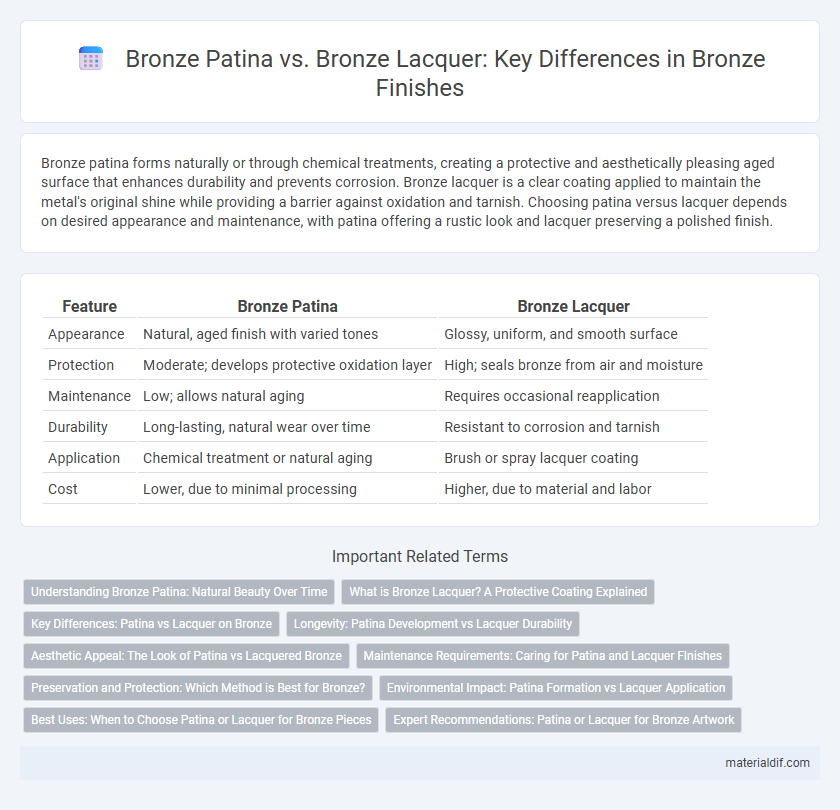Bronze patina forms naturally or through chemical treatments, creating a protective and aesthetically pleasing aged surface that enhances durability and prevents corrosion. Bronze lacquer is a clear coating applied to maintain the metal's original shine while providing a barrier against oxidation and tarnish. Choosing patina versus lacquer depends on desired appearance and maintenance, with patina offering a rustic look and lacquer preserving a polished finish.
Table of Comparison
| Feature | Bronze Patina | Bronze Lacquer |
|---|---|---|
| Appearance | Natural, aged finish with varied tones | Glossy, uniform, and smooth surface |
| Protection | Moderate; develops protective oxidation layer | High; seals bronze from air and moisture |
| Maintenance | Low; allows natural aging | Requires occasional reapplication |
| Durability | Long-lasting, natural wear over time | Resistant to corrosion and tarnish |
| Application | Chemical treatment or natural aging | Brush or spray lacquer coating |
| Cost | Lower, due to minimal processing | Higher, due to material and labor |
Understanding Bronze Patina: Natural Beauty Over Time
Bronze patina forms naturally through oxidation, creating a unique, protective layer that enhances the metal's aesthetic and resists corrosion over time. This organic process results in varied shades of green, blue, or brown, reflecting genuine aging and historical authenticity. In contrast, bronze lacquer provides an artificial, glossy finish that preserves the original color but lacks the evolving character of true bronze patina.
What is Bronze Lacquer? A Protective Coating Explained
Bronze lacquer is a transparent protective coating applied to bronze surfaces to preserve their natural color and prevent oxidation, which causes patina formation. Unlike bronze patina, which develops naturally over time as the metal reacts with air and moisture, bronze lacquer creates a barrier that blocks exposure to these elements. This coating is commonly used in decorative bronze items and outdoor sculptures to maintain a polished appearance and extend the metal's lifespan.
Key Differences: Patina vs Lacquer on Bronze
Bronze patina forms naturally or through chemical treatments, creating a durable, often greenish or brown surface layer that enhances corrosion resistance and aged appearance. Bronze lacquer is a clear protective coating applied to maintain the original metal shine by preventing oxidation and tarnish without altering the color. Patina changes bronze's texture and appearance permanently, while lacquer provides a reversible, glossy shield preserving the underlying metal's look.
Longevity: Patina Development vs Lacquer Durability
Bronze patina forms naturally over time, creating a protective layer that enhances the metal's resistance to corrosion and adds unique aesthetic value through color variation. Bronze lacquer provides an immediate, clear coating that shields the surface from oxidation but may degrade or chip with exposure, requiring periodic reapplication to maintain protection. While patina longevity increases with age and environmental conditions, lacquer durability depends on the quality of the coating and environmental exposure, often offering shorter-term defense compared to the enduring nature of patina.
Aesthetic Appeal: The Look of Patina vs Lacquered Bronze
Bronze patina develops a natural, aged look characterized by rich green, blue, or brown hues that enhance the metal's historical and organic aesthetic, while lacquered bronze maintains a uniform, glossy finish that highlights the metal's original warm, golden tones. Patina offers a textured, matte surface that appeals to those seeking a vintage or rustic charm, whereas lacquered bronze provides a smooth, protective sheen ideal for modern or polished designs. The choice between patina and lacquer affects the visual impact, with patina evoking a sense of depth and character, and lacquer emphasizing brightness and durability.
Maintenance Requirements: Caring for Patina and Lacquer FInishes
Bronze patina requires gentle cleaning with a soft cloth and mild soap to preserve its natural oxidation without stripping the aged surface, avoiding harsh chemicals that can damage the finish. Bronze lacquer demands regular dusting and occasional reapplication to maintain its protective barrier and glossy appearance, ensuring the coating does not chip or yellow over time. Proper maintenance extends the lifespan of both finishes, with patina emphasizing preservation of natural aging and lacquer focusing on protection and shine.
Preservation and Protection: Which Method is Best for Bronze?
Bronze patina naturally forms a protective oxide layer that prevents corrosion and enhances the metal's aesthetic appeal, making it ideal for long-term preservation in outdoor environments. Bronze lacquer provides a clear, durable coating that seals the surface against moisture and pollutants, offering superior protection for indoor or decorative bronze items. Choosing between patina and lacquer depends on the desired balance between natural aging and maintenance-free defense against environmental factors.
Environmental Impact: Patina Formation vs Lacquer Application
Bronze patina forms naturally through the oxidation process, creating a protective layer that reduces the need for chemical treatments and lowers environmental impact. Bronze lacquer requires synthetic chemicals and solvents during application, which can contribute to air and water pollution. The environmentally friendly patina process enhances bronze durability without introducing harmful substances, making it a more sustainable choice compared to lacquer coatings.
Best Uses: When to Choose Patina or Lacquer for Bronze Pieces
Bronze patina is ideal for artistic sculptures and antique restorations, providing a natural, aged finish that enhances texture and depth while protecting against corrosion. Bronze lacquer offers a clear, glossy protective layer suited for outdoor fixtures and functional objects requiring durability and ease of maintenance. Choosing patina emphasizes aesthetic aging and character, whereas lacquer prioritizes long-term protection and surface clarity.
Expert Recommendations: Patina or Lacquer for Bronze Artwork
Expert recommendations for bronze artwork emphasize the choice between patina and lacquer based on preservation and aesthetic goals. Patina offers a natural, aged appearance that enhances the metal's character while providing a protective layer through chemical treatment. Bronze lacquer creates a clear, durable coating that seals the surface against oxidation and environmental damage without altering the original color or texture.
Bronze Patina vs Bronze Lacquer Infographic

 materialdif.com
materialdif.com